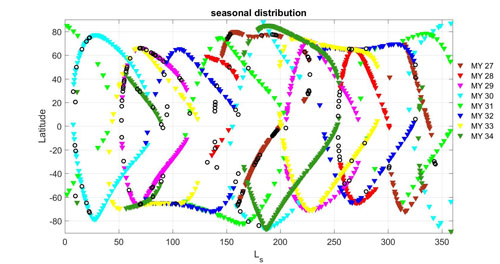Multi-annual monitoring of the water vapor vertical distribution on Mars by SPICAM on Mars Express
- 1Space Research Institute (IKI) RAS, Physics of planets, Moscow, Russian Federation (fedorova@iki.rssi.ru)
- 2LATMOS/CNRS, Guyancourt, France
Even if water vapor is a minor species in the Martian atmosphere it plays an important role in the planet’s climate. Major efforts were made to understand water vapor distribution during the last decades. Its seasonal cycle was studied in detail using nadir measurements by TES/Mars Global Surveyor, three experiments onboard Mars-Express, SPICAM, OMEGA and PFS, and by CRISM/Mars Reconnaissance Orbiter. In contrast to column abundance, the climatology of water vapor vertical distribution was scarcely documented until recently. The vertical distribution gauges multiple processes controlling the Martian water cycle, including the cloud formation with condensation, evaporation and sedimentation, sublimation and condensation on polar caps, the photodissociation and escape processes, and surface-atmosphere exchange [1]. A few spectrometers, SPICAM on MEX and ACS and NOMAD on TGO, carry out now the measurements of water vertical distribution from Mars’ orbit. They have got already prominent results as a supersatutation of water during the aphelion and perihelion season [2,3], high altitude water during global dust storms of MY28 [4] and MY34 [3,5] and high perihelion water in MY34 [3,6].
Observations
In this work, we present the first multi-annual survey of water vapor in the middle atmosphere of Mars based on SPICAM/MEx occultation measurements. SPICAM IR is an infrared spectrometer employing an Acousto-Optic Tunable Filter (AOTF) working in the spectral range of 1-1.7 μm with a spectral resolution of 3.5-4 cm-1, nearly constant in wavenumbers [7]. SPICAM can observe the H2O vertical distribution using the 1.38 µm band, the CO2 density in the 1.43 µm band, and the aerosol density and size distribution using several continuum portions of the spectrum. We analyzed Eight Martian years of H2O vertical distribution from MY27 to MY34.

Figure 1. Seasonal-latitudinal coverage of SPICAM observations in solar occultations for eight Martian years. The open circles mark faulty observations inapplicable for retrieval.
Results
The upper limit of water density detected by SPICAM varies from 50-60 km in aphelion to 70-90 km in perihelion. In aphelion (Ls=0-120°), the H2O mixing ratio <30 ppm at levels above hygropause. At Ls=60-120° the hygropause height varies from 15 to 25 km in middle northern latitudes. The perihelion season through regular years has not shown a prominent increase of the water content in high altitudes in the Northern hemisphere. In the Southern hemisphere the increase of density and mixing ratio was observed for all Martian years at an altitude of 50-80 km. The largest mixing ratio >100 ppm at 40-90 km was observed at Ls=240-290° in high and middle southern latitudes. We also present a comparison of two global dust storms of MY28 and 34 and we concluded that the GDS of MY28, coincident with southern summer solstice, shows a noticeably higher water increase.
References
[1] Montmessin, F., Smith, M., Langevin, Y., Mellon, M., & Fedorova, A. (2017). The Water Cycle. In R. Haberle, R. Clancy, F. Forget, M. Smith, & R. Zurek (Eds.), The Atmosphere and Climate of Mars (Cambridge Planetary Science, pp. 338-373). Cambridge: Cambridge University Press.
[2] Maltagliati, L., Montmessin, F., Fedorova, A., Korablev, O., Forget, F., Bertaux, J.-L., 2011a. Evidence of Water Vapor in Excess of Saturation in the Atmosphere of Mars. Science 333, 1868-.
[3] Fedorova, A. A., et al. (2020). "Stormy water on Mars: The distribution and saturation of atmospheric water during the dusty season." Science 367(6475): 297-300.
[4] Fedorova A., Jean-Loup Bertaux, Daria Betsis, Franck Montmessin, Oleg Korablev, Luca Maltagliati, John Clarke, Water vapor in the middle atmosphere of Mars during the 2007 global dust storm, Icarus 300, 15 January 2018, Pages 440-457.
[5] Aoki, S., et al. (2019). "Water Vapor Vertical Profiles on Mars in Dust Storms Observed by TGO/NOMAD." Journal of Geophysical Research: Planets 124(12): 3482-3497.
[6] Maltagliati, L., Montmessin, F., Korablev, O., et al. 2013. Annual survey of water vapor vertical distribution and water–aerosol coupling in the martian atmosphere observed by SPICAM/MEx solar occultations. Icarus 223, 942-962.
[7] Korablev, O. et al., 2006a. “SPICAM IR acousto-optic spectrometer experiment on Mars Express.” Journal of Geophysical Research: Planets 111(E9): E09S03.
How to cite: Fedorova, A., Montmessin, F., Korablev, O., Lefevre, F., Lacombe, G., and Bertaux, J.-L.: Multi-annual monitoring of the water vapor vertical distribution on Mars by SPICAM on Mars Express, Europlanet Science Congress 2020, online, 21 September–9 Oct 2020, EPSC2020-742, https://doi.org/10.5194/epsc2020-742, 2020

